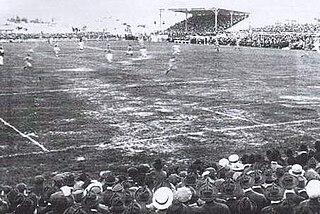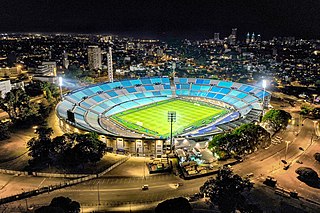
Club Atlético Peñarol, more commonly referred to as Peñarol, is a Uruguayan professional football club based in Montevideo. The club currently competes in the Uruguayan Primera División, the highest tier in Uruguayan football.

Club Atlético Independiente is an Argentine professional sports club, which has its headquarters and stadium in Avellaneda, a city of the Buenos Aires Province. The club is best known for its football team, which plays in the Primera División and is considered one of Argentina's Big Five football clubs.

Club Nacional de Football is a Uruguayan professional sports club based in La Blanqueada, Montevideo.

Defensor Sporting Club is a sports club based in Montevideo, Uruguay. Founded in 1913, Defensor has several sports sections, with football and basketball being the most important and the ones in which the club has achieved significant achievements in Uruguay and internationally.

Estadio Pocitos was a multi-use stadium located in the Pocitos district of Montevideo, Uruguay. The stadium, owned by C.A. Peñarol, was mainly used for football matches from 1921 to 1933. It was demolished later in the 1930s when Peñarol started to play in the Estadio Centenario as its home field, and additionally due to the increasing urbanisation of Montevideo.

The Estadio Gran Parque Central is the stadium of Club Nacional de Football. It is located in Montevideo, Uruguay, near Nacional headquarters, in the La Blanqueada neighbourhood.
The 1960 Copa de Campeones de América was the first season of the Copa CONMEBOL Libertadores, CONMEBOL's premier club tournament. Seven associations' clubs entered the first competition, with three not sending a representative. The first match of the tournament was played between Uruguayan side Peñarol and Bolivian side Jorge Wilstermann on April 19 in Montevideo, Uruguay.

Montevideo Wanderers Fútbol Club, usually known simply as Wanderers, is a Uruguayan professional football club based in Montevideo. The club are currently members of the Primera División and play at the Estadio Viera. Beside football, the club also has teams playing basketball, volleyball, athletics, futsal, pool and pelota.

Estadio Charrúa is a stadium in the Carrasco neighborhood of Montevideo, Uruguay, used mostly for rugby union and also sometimes for football. Property of the Montevideo Department, it is currently leased to the Uruguayan Rugby Union and Uruguayan Football Association after an agreement signed in 2012. The stadium holds 14,000 people.

José Leandro Andrade Quiroz was a Uruguayan professional footballer who played as a wing-half. He was nicknamed "the Black Marvel". During his prime he was regarded as one of the finest players in the world, contributing to the Uruguay national team's domination of international football during the 1920s, winning two consecutive Olympic gold medals and then the inaugural FIFA World Cup.

Football in Uruguay stands as the most popular sport. The Uruguay national football team has won two FIFA World Cup titles in addition to a record 15 Copa América titles, making them one of the most successful teams in South America. The national team won the first edition of the tournament in 1930, and won it again in 1950.
The 2008–09 Primera División season is the 77th professional season of Uruguay's top-flight football league.
The Campeonato Internacional de Verano, also known under its sponsored name Copa Bimbo, is an international exhibition football competition hosted in Montevideo, Uruguay, since 2009. It features four teams: Uruguay's two major teams Nacional and Peñarol, and guest teams from Argentina, Brazil and Paraguay. All matches are played at the Estadio Centenario in Montevideo, the home stadium of the Uruguay national team and the host of the 1930 FIFA World Cup Final. The tournament is produced and televised by Uruguayan telecommunications company Tenfield, and is sponsored by the Mexican bakery and food corporation Grupo Bimbo.
The 2009–10 Liga Profesional de Primera División season, also known as the 2009–10 Copa Uruguaya or the 2009–10 Campeonato Uruguayo, was the 106th season of Uruguay's top-flight football league, and the 79th in which it was professional. The season was named in honor of Héctor del Campo, ex-president of Danubio.
The 1989 Recopa Sudamericana was the first Recopa Sudamericana, a football competition for South American clubs that won the previous year's two most important competitions in the continent: the Copa Libertadores and the Supercopa Sudamericana. The inaugural edition was disputed between Nacional, winners of the 1988 Copa Libertadores, and Racing, winners of the 1988 Supercopa Sudamericana. The first leg was played on January 31 in Montevideo, while the second leg was played in Buenos Aires on February 6.
The 2011 Copa Libertadores de América finals were the final two-legged tie that decided the winner of the 2011 Copa Libertadores de América, the 52nd edition of the Copa Libertadores de América, South America's premier international club football tournament organized by CONMEBOL. The matches were played on 15 and 22 June 2011, between Brazilian club Santos and Uruguayan club Peñarol. Santos made their fourth finals appearance and first since 2003. Peñarol made their tenth finals appearance, and first since 1987. The two teams had previously met in the finals in 1962. Santos won the cup after beating Penarol 2–1 in the second leg of the final.

The Uruguayan Clásico is the most important rivalry in Uruguayan football and one of the best on the American continent. It is contested between the two most popular football clubs in Uruguay, Club Nacional de Football and Club Atlético Peñarol, both based in Montevideo. As of 2018, the two teams have won 96 of the 115 Uruguayan Primera División titles, and many international tournaments, including a combined eight Copa Libertadores. The first meeting between the two teams was at the turn of the century in 1900, making it one of the oldest football rivalries outside Great Britain. CURCC won the first match 2–0.

The Uruguay–Argentina–Chile–Paraguay 2030 FIFA World Cup bid, also known as the South American Bid or simply the South Bid, was an unsuccessful joint bid to host the 2030 FIFA World Cup by Uruguay, Argentina, Paraguay and Chile. The tournament's name would be Centenary World Cup.

The Argentina–Uruguay football rivalry, also known as Clásico del Río de la Plata, is a highly competitive sports rivalry that exists between the Argentine and Uruguayan national football teams and their respective set of fans. Considered by football journalists and fans alike as one of the most important rivalries in the sport, the derby is also the most played in football history. According to FIFA records, 197 official matches have been played to date, the first of which was played on 20 July 1902, in which both teams played the first international match outside the United Kingdom in Uruguay, with Argentina winning by 6–0.

The 2021 Copa Libertadores final was the final match which decided the winner of the 2021 Copa Libertadores. This was the 62nd edition of the Copa Libertadores, the top-tier South American continental club football tournament organized by CONMEBOL.



















